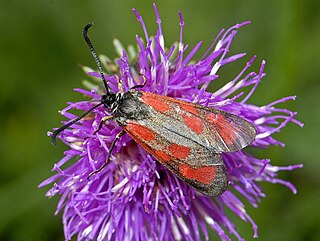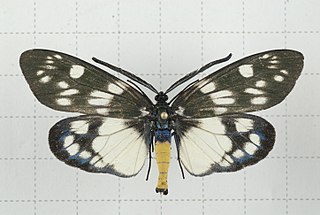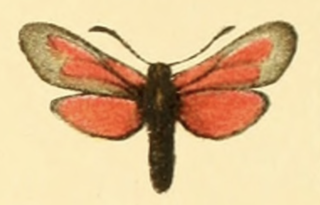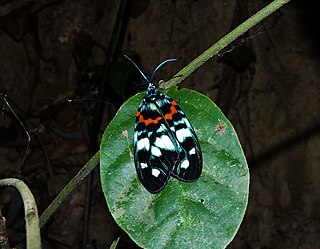
The Zygaenidae moths are a family of Lepidoptera. The majority of zygaenids are tropical, but they are nevertheless quite well represented in temperate regions. Some of the 1000 or so species are commonly known as burnet or forester moths, often qualified by the number of spots, although other families also have 'foresters'. They are also sometimes called smoky moths.

Zygaena transalpina is a moth of the family Zygaenidae.

The nine-spotted moth or yellow belted burnet is a moth in the family Erebidae. The species was first described by Carl Linnaeus in his 1758 10th edition of Systema Naturae.

Zygaena ephialtes is day-flying species of burnet moth found in Europe. It is typically found in xeric habitats, and populations have recently decreased. It also exhibits Müllerian mimicry with other species, like Amata phegea.

Zygaena loti, the slender Scotch burnet, is a moth of the family Zygaenidae. It is a diurnal moth characterized by a black body, light colored legs, and red spots on its wings. The caterpillars are a yellow-green color and usually molt out of dormancy in late February to early March. The larvae feed on plants from the family Fabaceae until they enter their pupal stage and mature into adults in May to early June. For mating, Zygaenidae exhibit a dual-partner finding strategy, where females use pheromones while assuming a calling position, and males exhibit a patrolling behavior where they utilize both vision and the olfactory receptors in their antennae to locate a potential mate. Although regionally endangered as their population is declining, Z. loti is found all across Europe, inhabiting areas rich in their desired food plants: lime-rich, and characterized by a hot and dry climate. The decreases in their population are likely due to factors such as habitat loss and fragmentation brought on by commercial agriculture and urbanization, as well as global climate change. There are few conservation programs currently focusing on Zygaena loti.

Zygaena purpuralis, the transparent burnet, is a moth of the family Zygaenidae.

Gynautocera papilionaria is a moth of the family Zygaenidae. It is found in south-east Asia, including northern India, Thailand, Laos, Assam, Burma, Vietnam, Tonkin, Hainan, Sumatra, Java, Lombok, Celebes, Amboina, Buru and Batjan. Larvae have been recorded on Litsea monopetala.

Gynautocera is a genus of moths of the family Zygaenidae.

Pollanisus viridipulverulenta, the satin-green forester, is a moth of the family Zygaenidae. It is found in the eastern part of Australia.
Pollanisus empyrea is a moth of the family Zygaenidae. It is endemic to the temperate parts of the Australian state of Western Australia.
Homophylotis artonoides is a species of moth in the family Zygaenidae. It is found in Australia from Queensland.
Myrtartona coronias is a species of moth in the family Zygaenidae. It is found in eastern and south-eastern Australia, from southern Queensland to Tasmania.
Myrtartona leucopleura is a species of moth in the family Zygaenidae. It is found in Queensland, New South Wales and the Australian Capital Territory.
Pseudoamuria neglecta is a species of moth in the family Zygaenidae. It is found in Queensland, Australia.

Eterusia aedea, the red slug caterpillar, is a species of moth in the family Zygaenidae. It was described by Carl Linnaeus in his 1763 Centuria Insectorum. It is found in Sri Lanka, India, Nepal, Taiwan, Japan and China.

Zygaena lavandulae is a species of moth in the family Zygaenidae.

Zygaena rhadamanthus is a species of moth in the Zygaenidae family. It is found in France, Spain, Portugal and Italy.

Milleria adalifa is a moth in the family Zygaenidae. It is found in Asia.

Zygaena mana is a species of moth in the Zygaenidae family. It is found in Adshara Gebiet, Georgia, "Transkaukasien" and Armenia. It is similar to Zygaena brizae but differs in that the hindwing is more broadly edged with black.

Erasmia pulchella is a species of moth in the burnet moth family Zygaenidae and in the subfamily Chalcosiinae. It was described by Frederick William Hope in 1840. It is found throughout Southeast Asia, with its range stretching from northern India, Myanmar, Laos, Thailand, Vietnam, China, Taiwan, and Japan. It is the type species of the genus Erasmia.















